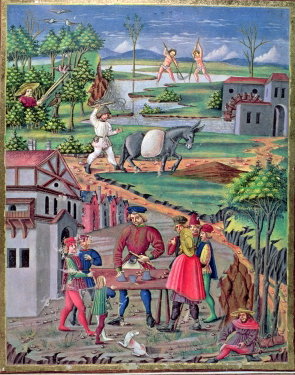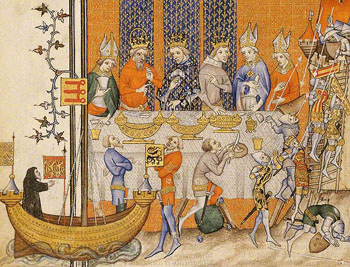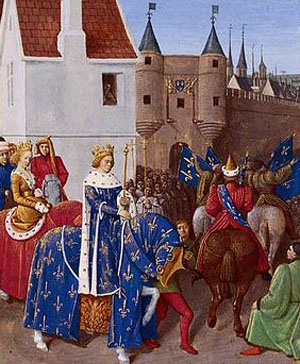 |
World History
Medieval Work & Leisure
Hugh O’Reilly
There was a different pace of work and concept of leisure in the Middle Ages. Work followed the natural rythmn of the day and seasons; leisure was plentiful, governed by the feast days of the liturgical calendar. It seems that today's man, instead of scorning the so called Dark Ages, should envy the medieval man, who enjoyed so many holidays. Regine Pernoud helps us understand how the medieval people worked and rested.
The rhythm of the working day in the Middle Ages varied a great deal in accordance with the seasons. It was the parish bell or that of the neighboring monastery that called the artisan to his workshop and the peasant to his field, and the time to ring the Angelus varied with the length of the natural day.
As a rule, people rose and went to bed at the same time as the sun. In winter, therefore, work began at about eight or nine o'clock and finished at five or six. In summer on the other hand, the day began at five in the morning and did not end until seven or eight at night. These are still the regular working hours of peasant families.

Work and leisure in the countryside |
But it was not thus every day. First, people worked a five-and-a-half day week: Each Saturday and on the eve of every feast day, work stopped at one o'clock in some trades and for everyone at the hour of Vespers, that is, at four o'clock at the latest. The same rule applied to certain days that were observed without being kept as actual holidays, that is, about 30 days in the year, such as Ash Wednesday, Rogation Days and Childermas (the Slaughter of the Innocents), etc.
People also rested on the day of the patron saint of their guild and of their parish, and there was, of course, a complete holiday on Sundays and on holy days of obligation. These were very numerous in the Middle Ages – 30 to 33 a year, according to the province. Then, in addition to the four festivals observed in France today, there were, not only All Souls' Day, Epiphany, Easter Monday and Whit Monday and three days in Christmas week, but also a number of festivals, which pass almost unnoticed now, such as the Feast of the Purification, the Invention and Exaltation of the True Cross, the Annunciation, St. John's Day, St. Martin's Day, St. Nicholas' Day, etc.
The liturgical calendar thus governed the whole year and introduced great variety into it, especially as more importance was attached to these festivals than nowadays.
It was, moreover, from such feast days, and not from the day of the month, that time was reckoned: One spoke of St. Andrew's Day, and not of the 30th of November, and of three days after St. Mark's Day rather than of the April 28. People would also waive social obligations, such as those of justice in their honor: Insolvent debtors who were obliged to reside at a fixed abode – a system that calls to mind the debtors' prison, though in a milder form – were allowed to leave their residence and to come and go freely from Thursday in Holy Week until Easter Tuesday, from Whit Saturday to Whit Tuesday, and from Christmas Eve until the Feast of the Circumcision of Christ. These are notions that it is hard for us to grasp today.
Altogether there were about 80 days of complete rest with over 70 partial holidays, that is, about three months of rest spread over the year. This ensured infinite variety in the routine of work. During this period, people might well have complained, like the cobbler in La Fontaine's fable, of having too many holidays!
Feast days theater & mystery plays

Performers stage a Crusaders play before the royal table |
The organization of leisure had a religious basis: every holiday was a festival and every festival began with religious ceremonies. These were often long and always solemn. They were followed by mystery and miracle plays which, initially performed in the local church, were soon transferred to the cathedral square.
There were scenes from Christ's life, of which the principal, the Passion, inspired masterpieces that have been rediscovered in our own epoch. The Virgin and the Saints also inspired dramatic works and everyone knew the Miracle de Theophilus, which had an extraordinary appeal.
These shows were essentially popular, in the sense that both the actors and audience were drawn from the people. Their audiences were alert and responsive to the smallest detail of scenes, which roused in them sentiments and feelings quite different from those provoked by present-day drama, since it was not only the intellect and the emotions that were involved, but also deep-seated beliefs.
Not only purely religious dramas were performed on the stages set up on the public square, but plays with historical or romantic themes or burlesques and satirical farces also. Nearly all the towns had their own theatrical company, and that of the Clerks of the Law Courts in Paris became famous.

King John II and entourage entering Paris in 1350 |
Public rejoicings also had their place alongside religious festivals: There were sometimes magnificent processions that marched through the streets on the occasion of the assemblies and plenary courts held by the Kings, recalling the Champs de Mars or the Champs de Mai, to which Charlemagne summoned the nobility of the land at Poissy or at Aix-la-Chapelle.
On these occasions the French Court enjoyed displaying a ceremonial pomp, and the towns were decorated with all splendor imaginable, as they were for the entry of Kings or great vassals. Tapestries were hung along the walls, the houses were decorated with leaves and greenery and the streets strewn with flowers.
This was done especially for the coronation of a King: The cities through which he passed after the ceremonies in Rheims were each eager to give him a reception, but this was in not necessarily a formal or pompous affair. Sometimes it was accompanied by farcical processions where tumblers and professional entertainers, mingling with the public, performed a hundred tricks to amuse the people. It was not until the entry of Henry II into Paris in 1550 that it was decided to do away with these merry-makings and entertainments ‘of bygone days.’

Based on Regine Pernoud, The Glory of the Medieval World
London: Dennis Dobson, n.d., pp. 242-245
Posted October 14, 2011

Related Topics of Interest
 The Middle Ages - A World of Brilliant Colors The Middle Ages - A World of Brilliant Colors
 The Middle Ages, a Forest Filled with Symbols The Middle Ages, a Forest Filled with Symbols
 Refuting Myths of the Middle Ages Refuting Myths of the Middle Ages
 Women in the Middle Ages Women in the Middle Ages
 Departure for the First Crusade Departure for the First Crusade
 Hernan Perez del Pulgar of the Valiant Deeds Hernan Perez del Pulgar of the Valiant Deeds
 The Three Orders of Medieval Society The Three Orders of Medieval Society

Related Works of Interest
|
|
History | Home | Books | CDs | Search | Contact Us | Donate

© 2002- Tradition in Action, Inc. All Rights Reserved
|
 |
|